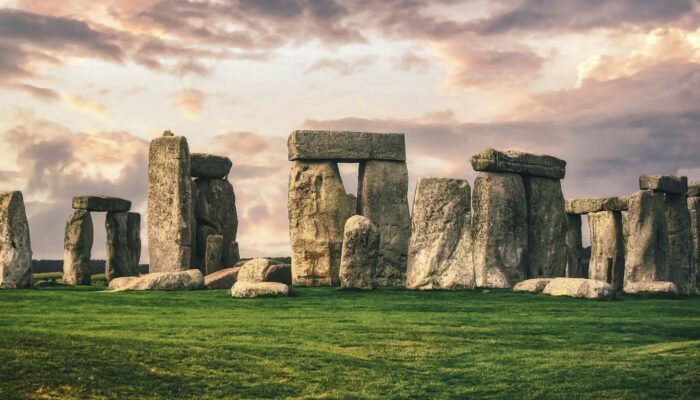
In June 2024, climate activists sprayed Stonehenge orange, demanding urgent action from the British government to phase out fossil fuel. This divisive act evoked a destructive yet often overlooked impact of climate change: the damage and destruction of cultural heritage. We are losing our cultural heritage at an unprecedented speed and scale to climate change, according to a 2022 report by the European Commission. Extreme climate events are coupled with insidious, deteriorative processes that threaten not only monuments but a deep pool of connected, often intangible characteristics that define culture.
Whilst defending the activists attempt to bring attention to much-needed action on climate change, some supporters stripped Stonehenge of its cultural value and depicted it as merely stone. Whilst Stonehenge has weathered much throughout its history, dismissing its cultural value risks feeding into broader trend in climate reporting and decision-making: damage to cultural heritage has been historically overlooked despite its harmful knock-on effects on social cohesion and climate resilience.
Nature nurtures culture nurtures nature
Human societies develop in tandem with landscapes: how communities navigate, adapt to, and utilise their local environment informs their behaviours and beliefs. Traditional knowledge and practices arise from people’s relationship with the landscape, informing the patterns of behaviour and belief that construct culture: building and clothing material, artisanal crafts, land-use and subsistence patterns, livelihood, arts, identity, belief, folklore and spirituality are all affected by and continue to influence cultural heritages. Nature and culture are not separate but co-evolving processes; society is eco-cultural.
Eco-cultural development occurs not only in local communities but also on a broader scale: while smaller societies may develop idiosyncratic beliefs and practices, larger populations identify with the characteristic environments of regions and countries. This relationship also extends to the extraterrestrial: cultures have long looked to the stars for navigation, chronology and inspiration. Whilst less tangible than material heritages such as landscapes, arts and monuments, it is the intangible beliefs that give the tangible value.
Losing ground
Climate change is already damaging our cultural heritage: 20% of heritage sites along Africa’s coastline are threatened by sea-level rise. This number may increase to 70% if emissions remain high. Damage to ecosystems, biodiversity and agriculture forces migration and challenges social cohesion: for Amazigh communities in North Africa, exacerbated droughts has meant women take on greater community responsibility as men travel further looking for work. The government of Tuvalu, faced with their island nation being overcome by rising sea levels later this century, has proposed a virtual nation to preserve their culture and connect their diaspora.
Although the climate crisis has and will exacerbate the risk to cultural heritage, this threat is not new: centuries of industrial and colonial processes has already damaged environments and displaced or erased the communities that lived alongside them. Light pollution is increasing globally: a child born today in a light polluted area may experience quadruple increase in light pollution by their 18th birthday, with the number of the stars they could see diminishing from 250 to 100. Rapid urbanisation and private enterprise has diminished our access to the astronomical commons.
Loss and damage
The term “loss and damage” is used in UN climate talks and beyond to refer to the economic and non-economic impacts of climate change. The topic is a banner under which the nations most vulnerable to climate impacts have campaigned for financial support, with the compensatory burden on the shoulders of the wealthy nations which have contributed the most to the climate crisis historically.
Cultural heritage sits uneasily within the loss and damage framework: climate impacts on assets can be accounted for whilst cultural heritage defies traditional measures by including the tangible and intangible – heritage sites, sense of identity or place, mental health, biodiversity, arts and storytelling, spirituality and belief, and loss of life to name a few. Classed as non-economic losses, intangible losses are deeply intertwined with tangible heritage, and will directly impact upon and exacerbate economic losses. Climate loss and damages reshape cultural practices and beliefs, ultimately threatening human health and social cohesion.
According to the IPCC Sixth Assessment Report, the inclusion of such intangible losses in economic reporting would push loss and damage values higher. Why is the threat to cultural heritage overlooked?
The cultural overlook
What should be included under loss and damage is contentious, with progress stymied by wealthy and historically high carbon-polluting nations reckoning with potential increases in financial reparations and the risk of litigation. The resulting ambiguity means accounting for loss and damage is often speculative or neglects certain climate impacts entirely; the 2024 IPCC Sixth Assessment Report highlights how the ambiguity surrounding “loss and damage” has hamstrung the development of effective policy. Where there is ambiguity there is no accountability.
Reporting on loss and damage is not comprehensive. The economic impacts of climate change are not fully accounted for whilst non-economic losses are reported on little. This is partly due to difficulty in measuring the impact of climate change on culture as socio-economic conditions vary geographically and are constantly evolving. The precedence given to monetary losses in UN discussions means losses considered non-economic – such as cultural heritage loss – have been historically neglected.
Furthermore, extant reporting methods on cultural heritage loss are unequal: the UNESCO database of heritage sites is frequently to on those vulnerable to climate change. However, UNESCO is biased towards European and nationally-recognised heritage sites, resulting in a paucity of non-European and local heritage sites being represented. The IPCC also reports unevenly how climate change impacts cultural heritage, whilst reviews of the scientific literature shows a bias towards Europe, North America, and Australia with a dearth of studies in other regions. Meanwhile, intangible impacts receive little to no focus in grey literature.
Finally, there is the question of whether intangible losses should include in loss and damages at all; financial compensation cannot wholly compensate for the loss of life, belief and meaning. There is a conflict between the economic understanding of the world and the sacred. Economics is concerned with material prosperity. The sacred is the concerned with spiritual prosperity. It is not possible to measure the immaterial with the material; its meaning is not assigned by metric but by the nimbus of culture.
This speaks to a broader problem in loss and damages reporting: decision-makers require complex information to be communicated by measure. However, in doing so meaning is lost. The numbers included in climate change reporting is compelling – the scale of disaster, its magnitude, its cost inflicted and the number who are suffering – but the total experience cannot be known and accessed. When we attempt to account for cultural loss by reporting a measure, we risk losing the meaning which informs the patterns of belief and behavior. Actions to mitigate and adapt communities to climate change are then implemented without understanding their eco-cultural dynamic, risking maladaptation and damage.
Steps toward recognition
Cultural heritage has gained traction in recent climate discussions: since 2021, the United Nations Human Rights Council has recognized the right to life, mental health and culture as indivisible from the human right to a sustainable environment. COP28 saw the creation of a loss and damage fund inclusive of some tangible and intangible cultural losses, despite meagre commitments by wealthy, carbon-polluting nations. The protection of cultural heritage was also included as a key target in a new framework for Global Goals on Adaption.
The European Union has developed policy mechanisms address climate impacts on cultural heritage through network-building and improving collaboration, research and education initiatives. However, cultural policies are the responsibility of the member-state and its competencies are limited to non-binding recommendations. A 2024 report by the European Parliament reveals a sparse inclusion of climate impacts on cultural heritage in the EU’s grey literature, with a limited awareness about related policies at both the member-state and EU level. An earlier report highlighted how little such policy has been picked up nationally, with only seven member-states having some kind of collaborative policy about the impacts of climate on cultural heritage. Of these, the majority focused on tangible heritage.
Community voices for climate solutions
Protecting cultural heritage requires reconceiving heritage strategies as adaptive rather than conservative. This ostensive contradiction between preservation and change can be reconciled by rethinking policy as focused on development rather than conservation. Human culture is constantly evolving in response to a changing, respondent environment. The rate of climate change threatens the continuity of culture as humans a forced to adapt within a generation. It is not enough that loss and damage to cultural heritage should be acknowledged, but it should also invest in generating conditions for the survival of culture. To do so, we need increased inter- and intranational collaboration between scientists, practitioners, policy-makers and local communities. Ultimately, the development of any policy championing an adaptive and resilient cultural heritage must be led by the communities it affects.
In 2022, a resolution by the European Parliament acknowledged how traditional knowledge can aid efforts to reduce the impacts of climate change; traditional knowledge provides important information on the local environment, including sustainable solutions propagated by traditional crafts and behaviours. The loss of local knowledge and cultural heritage is correlated with reduced social cohesion and climate resilience, and so protecting cultural heritage is an act of climate resilience.
However, climate policies can themselves risk loss and damage to cultural heritage, reducing our capacity to adapt as traditional knowledge is lost. This risk can be reduced by engaging communities throughout the entire process of policy planning and implementation, such as through public consultation and creating positions for community members in decision-making process. This also extends to the involvement of indigenous voices within reporting organisations like the IPCC and UNESCO, which have been found to be biased towards western expertise. At the governance level, protecting cultural heritage is often included under conservation, separate from development policies and sometimes considered a dual-if-separate problem to climate impacts. A more collaborative and interdisciplinary approach is needed to de-silo policy if cultural heritage is to be protected.
The indivisible right to culture, a sustainable environment and life is something that must be defended. For cultural heritage, that means damage and loss is acknowledged and that those most affected are included – and lead – in climate strategy.



